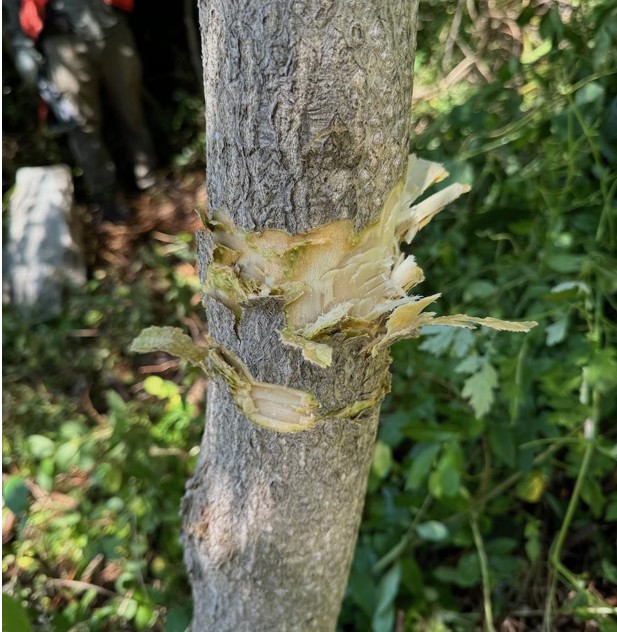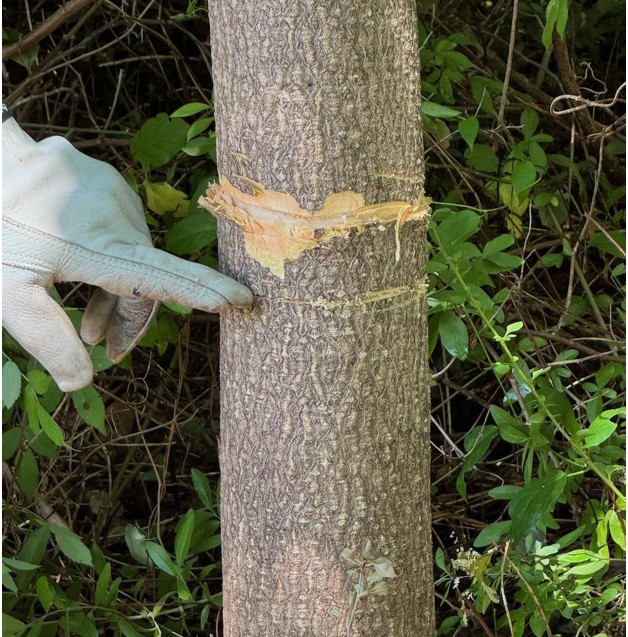Notes from a Workshop by Peter Picone, CT DEEP
Coogan Farm Nature and Heritage Center
162 Greenmanville Ave, Mystic, CT
June 27, 2024
Ailanthus altissima (Tree-of-Heaven, ToH) is listed as invasive in Connecticut. In addition to forming large clonal colonies that crowd out native trees and understory plants, ToH produces allelopathic chemicals that inhibit the germination of most native plants. Mature female ToH trees can produce more than 300,000 winged seeds (samaras) each year that disperse by wind to initiate new colonies. ToH also serves as a preferred host for spotted lanternfly (Lycorma delicatula), a sap-sucking invasive Asian planthopper that has been expanding its range into New England, threatening wine grapes, fruit orchards, timber trees and other economically important crops.
Identification of ToH. It is not difficult to distinguish ToH from other look-alike trees or shrubs with pinnately compound leaves like sumacs and walnuts. ToH has leaves with relatively smooth margins, glandular teeth at base of leaflet, alternating stems with a large V or heart-shaped bud scar, twigs with spongy brown pith, tree bark resembling cantaloupe skin, and a strong, offensive smell when any part of plant is crushed. ToH is dioecious, meaning there are separate male and female plants with only female plants producing seeds. Flowering occurs soon after the trees finish leafing out in June. Dense clusters of small greenish blooms at the branch tips develop into highly visible orange seed clusters. Control of mature female trees should be prioritized to prevent seed production.
Peter’s best practices for the control and elimination of ToH have been honed by decades of professional and personal experience managing invasive plants in Connecticut. He has observed the response of ToH to different control techniques over many years and has conducted long-term monitoring to enable him to claim success in eliminating ToH from a site. This body of experience has also informed his conclusion that managing large infestations of ToH without the use of herbicide is not currently feasible.
ToH is particularly difficult to manage because of its extensive root system and propensity to sprout from long horizontal roots (rhizomes). Small trees (less than 2 inches in diameter) can be hand cut or mowed with a forest mulcher, but larger stems need to be treated with herbicide in a manner that kills them slowly without stimulating clonal sprouting. Cutting the main trunk induces vigorous suckering and root sprouting up to 50 feet away (clonal sprouting). Cut stump treatment with herbicide does not prevent root sprouting. Peter has found that the best way to eliminate ToH is by using the herbicide triclopyr on standing trees; this method has resulted in the slow death of the trees over 3-8 years. When done right, clonal sprouting is markedly reduced albeit not eliminated, so follow-up for several growing seasons is still necessary to eliminate new trees.
How to cut ToH for herbicide treatment is determined by trunk diameter and by the tools available. For small trunks having a minimum diameter of 2 inches up to around 6 inches, Peter uses a small hatchet held at a downward angle to make sharp shallow cuts entirely encircling the trunk about 2 feet above the ground. The cuts should extend through the bark and cambium layers into the outer wood (sapwood) but leave the bark attached (see Figure 1). On a slighter larger trunk, he demonstrated use of a branch saw held at a slight downward angle to make two shallow girdling cuts around the trunk, then used a hatchet to shave off a small amount of bark around the upper girdling cut (Figure 2). On a pair of larger trunks (1-ft diameter) that belonged to a single tree, Peter used an electric chainsaw to make double girdling cuts a few inches apart around each trunk (Figure 3). All trunks were cut at a height of 1-3 ft above ground level.



How to apply herbicide. While girdling cuts disrupt nutrient transport in tree trunks, the application of liquid herbicide into the cuts facilitates slow killing of ToH, even as the tree attempts to heal over the narrow wounds. Undiluted herbicide is delivered directly into the fresh cuts using a small spray or squirt bottle, using only as much as will saturate the cut without dribbling excessively down the trunk or spilling onto surrounding vegetation. Herbicide should be applied within an hour or so of cutting. Angled cuts hold liquid, allowing more herbicide to be taken up by the tree. Herbicide is taken up and moved throughout the tree through its vascular channels (phloem and xylem). During the early summer, herbicide is eventually transported throughout the entire tree, but after midsummer, there is greater transport into the roots.
Visible evidence of herbicide action may not appear for up to several weeks (wilting and browning leaves) depending on the volume and concentration of herbicide that was taken up. Peter indicated that repeated herbicide treatment is generally not necessary for ToH and may even be counterproductive. Treated trees should be monitored for evidence of toxicity to their top growth and for new root sprouts that should be treated by foliar spraying after they leaf out. Elimination of ToH requires monitoring for 3-5 years after the primary year of control and continuing to treat or remove new root sprouts until no further sprouting occurs, indicating that the roots have finally died.
The preferred herbicide for ToH is triclopyr triethylamine salt (aka “triclopyr amine,” brand name Garlon 3) which can be purchased as a concentrated solution where it comprises 8% to 44% of total ingredients. Triclopyr is selectively toxic to dicots (woody and most broadleaf plants) at concentrations that do not harm monocots (grasses and related plants) and is safe for people and animals. Read the product labels carefully to ascertain that triclopyr is the ONLY active herbicidal ingredient and that the concentration is suitable for use on ToH – some ready-to-use products are too dilute. Peter uses 44% solution without dilution for ToH trunk treatment. Concentrated solutions can be purchased online; however, concentrations as low as 8% which include products commonly sold as brush killers or poison ivy control appear to be effective. Peter mentioned that Hamden Land Trust habitat steward Tim Mack is having success with managing Tree of Heaven on their Rocky Top Preserve. Note that other forms of triclopyr such as triclopyr ester, Garlon 4A, may also be used to treat ToH but are poorly water soluble so they require the addition of an emulsifier or surfactant that is sold for this purpose.
Triclopyr amine diluted with water is used as a foliar spray to treat root sprouts and saplings less than 8-10 ft tall. Consult the product label for the recommended dilution for ToH. Foliar spraying should only be done when air temperatures are in the range 50°F-80°F and winds are light or calm to avoid damage to nontarget plants from spray drift. Where the proximity of desirable vegetation precludes foliar spraying, basal bark or cut stump treatment may be substituted. Hack and squirt or basal bark treatment are effective over a somewhat wider temperature range, 50°F-90°F. Peter emphasized that all herbicides should be used in strict accordance with their labels. (To learn more about triclopyr, see section 7k in The Weed Control Handbook, The Nature Conservancy (2001). This manual also has good descriptions of different techniques for herbicide application including basal bark application.)
Personal protective gear should be used when treating ToH. Anyone using sharp tools, particularly chain saws, should wear eye protection, long sleeves, long pants, leather gloves and chaps to avoid flying debris and accidentally cutting themselves. The person handling herbicide should wear nitrile gloves, eye splash protection, and long sleeves. If out in the field, have a bucket of water available for emergency washing in case of a spill or accidental skin contact. Since personal protection requirements differ for individuals hacking or girdling trees versus applying herbicide, Peter suggested that only one person in each crew be assigned to handle herbicide.
When to control ToH? Treatment is most effective once ToH trees have fully leafed out in late spring until they begin to go dormant (foliage color change) in mid-fall. In southern New England, this is typically late June through mid-October. Within this seasonal window, earlier treatment (before July 1), especially of female trees, can reduce or prevent seed production.
Exceptions: A situation where this method should not be used is where large ToH grow along trails and dead trees left standing pose falling hazards to trail users. Arborists generally will not work on dead trees because their structure may be internally compromised, making the direction of fall less predictable. In this case, there may be no choice but to cut down the live trees and to be prepared to manage subsequent root sprouting. According to Rutgers Cooperative Extension (2021), if ToH is treated at least 30 days prior to being cut down, it is more likely to have translocated herbicide throughout its entire root system, which should reduce resprouting. Also, since standing trees do not die quickly, they may be taken down during the winter following treatment.
Treatment Observations through August 3, 2024: The treated trees shown in Figure 1 and Figure 3 showed significant wilting and browning of leaves (top dieback) within two weeks following treatment. As of August 1, top dieback was not yet complete for the larger tree but has continued to progress. The medium-sized tree in Figure 2 was not treated with herbicide due to its proximity to the trail. After 5 weeks, it showed no ill effects from the shallow girdling cuts alone.
MATERIALS:
- Small hatchet Branch saw
- Electric chainsaw Leather work gloves
- Chaps (if using a chainsaw)
- Bottle with adjustable spray nozzle (16 oz-32 oz) Funnel (for filling bottle)
- Measuring cup for liquids (to dilute herbicide as needed) Nitrile gloves
- Safety eyeglasses/goggles (eye protection)
- Triclopyr triethylamine (amine, salt) 8% – 44% concentrate (Garlon 3A or generic equivalent) is best for hack and squirt application.
- Bucket of water (emergency wash station)
REFERENCES:
Tu, M. et al. Weed Control Methods Handbook, The Nature Conservancy (2001), pp.163-170 (7k. Triclopyr). https://www.invasive.org/gist/products/handbook/methods-handbook.pdf
Rettke, S. Tree-of-Heaven: Best Herbicide Treatment and Removal Timing. Plant and Pest Advisory, Rutgers Cooperative Extension, December 29, 2021. https://plant-pest-advisory.rutgers.edu/tree-of-heaven-best-herbicide-treatment-and-removal-timing/
Wallace, V., Siegel-Miles, A., Sowizral, K. CIPWG Invasive Plant Factsheet: Tree-of-Heaven (Ailanthus altissima), updated January 2022. https://ipm.cahnr.uconn.edu/invasive-species/invasive_plants_tree-of-heaven/
CONTACTS:
Lydia Pan
Email: lcpan01@gmail.com
860-383-3580
Peter Picone
Email: Peter.Picone@ct.gov
860-424-3032
Prepared by Lydia Pan
President, Wild Ones Mountain Laurel Chapter
DPNC Volunteer Lead for Habitat Restoration at Coogan Farm 08/03/2024

